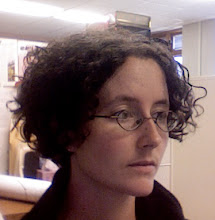We spent the morning in orientation hikes. This place is amazing! The wildlife is completely intact (except for harpy eagles, which haven't been seen here since 2001 or so). And the animals are dense. There are more huge canopy trees than La Selva, too, and more diverse plants. I saw squirrel monkeys this morning, little guys with tufty tails. This species is endemic to the Osa, and the only Central American squirrel monkey. Corcovado has 4 monkey species, and now I've seen them all. I'm really going to miss that rustling in the tree canopy when we leave!
Strangler figs are quite common here, and spectacular. I'll try to upload some photos. A mature strangler fig looks like a thick, snaky cage around the host tree. We saw fig fruits today, too -- another famous ecological story, fig-fig wasp coevolution. We cut it open and tiny wasps came pouring out.
It feels hotter and wetter here than at La Selva, even though Corcovado supposedly has a stronger dry season. I don't think I've ever sweated this much in my whole life. When I put on clean clothes, they are soaked through within a couple of hours. I've only really got 2 pairs of clothes. We do all our laundry by hand, and it takes at least one day (with luck) for it to dry. I think you can all imagine what that means for my odor and appearance. Luckily I'm not alone. :) And I have extra socks and underwear. I'm also grateful to have discovered gold bond powder -- excellent stuff! Definitely invented for the rainforest. I use it everywhere.
For some reason, the course coordinators have decided to schedule lectures for 1:00, right after lunch. Don't do this, people! Siesta was invented for a good reason. Something about the heat and wet is exhausting, and it hits hardest right about then. At least half of the class slept through the lecture on the national park. I managed to stay alert enough to understand that gold mining and poaching are constant problems here, and that the financial situation is dire. Local and national politics are complex and tangled, and Corcovado is suffering for it. It takes a lot of money just to pay the 20-some guards necessary to enforce the park's no-extraction policy (wood, gold, meat). But Corcovado is a big attraction for a certain kind of tourist, and brings in more money than it needs to maintain itself. Then the government redistributes the money, leaving Corcovado in the red. It's too complicated for anyone to see an easy fix, but hopefully all involved parties will agree that this place should be the very highest priority. It's incomparable, a truly intact ecosystem. This land supports healthy jaguar and tapir populations! That must be preserved.
Subscribe to:
Post Comments (Atom)

No comments:
Post a Comment